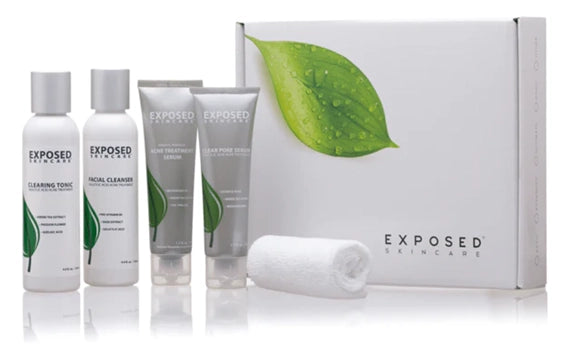Yes, vitamin D can help fight acne, and science backs this up. Your sebaceous glands actually have vitamin D receptors, and low levels can trigger inflammation and more breakouts (which explains why your skin freaks out in winter). You can boost your levels through sunshine, fatty fish, or supplements—but Exposed's formula combines vitamin D with other acne-fighters for a more thorough approach. The full story might surprise you.
Biggest Takeaways
- Research shows vitamin D deficiency correlates with increased acne severity and inflammation.
- Vitamin D receptors in sebaceous glands help regulate oil production and reduce clogged pores.
- Vitamin D's anti-inflammatory properties address acne-related inflammation and help balance immune response.
- Exposed combines vitamin D with benzoyl peroxide and salicylic acid for a comprehensive anti-acne approach.
- Sources include sunlight (10-30 minutes several times weekly), fatty fish, fortified foods, and supplements (400-800 IU daily).
The Science Behind Vitamin D and Acne

While scrolling through endless acne advice online feels like falling into a rabbit hole of contradictions, the relationship between vitamin D and your skin actually has some solid science behind it.
So, does vitamin D help acne? Research points to yes. Studies show that people struggling with breakouts often have lower vitamin D levels in their blood. It's not just coincidence—your sebaceous glands literally have vitamin D receptors, suggesting it helps regulate that pesky oil production.
What's really telling is how vitamin D's anti-inflammatory properties directly target one of acne's main drivers: inflammation.
And notice how your skin acts up during winter? That's when your vitamin D levels naturally dip.
The science is clear—vitamin D isn't just another overhyped supplement. It's actually tackling your acne from multiple angles.
How Vitamin D Deficiency Affects Your Skin
When your vitamin D levels take a nosedive, your skin often throws the first tantrum. Over 41% of Americans are walking around vitamin D-deficient without even knowing it, and their complexions are paying the price.
Think of it as your skin's silent rebellion. Low vitamin D cranks up your body's inflammation response, turning minor breakouts into angry, red protest zones across your face. Those stubborn pimples that won't quit? They might be waving the vitamin D deficiency flag.
Winter months are especially brutal—less sunshine means less natural vitamin D production, creating the perfect storm for seasonal breakouts. Your pores get clogged more easily, and suddenly you're wondering why your usual routine isn't cutting it anymore.
The truth? You can't fix a four-driver problem with a one-driver solution.
Vitamin D's Anti-inflammatory Benefits for Breakouts

Vitamin D doesn't just fight deficiencies—it's your skin's built-in fire extinguisher.
When acne flares up, this sunshine vitamin swoops in to calm the angry redness and swelling that makes you want to hide under your hoodie.
Science backs this up: people with lower vitamin D levels tend to battle more severe breakouts.
It's not just coincidence—your skin literally can't regulate inflammation properly without adequate D.
This vitamin is quietly working double-duty, balancing your immune response and controlling cell growth to keep pores from getting stuffed with dead skin and oil.
But here's the truth most brands won't tell you: tackling just one acne driver (like inflammation) won't clear your skin for good.
You need to hit all four simultaneously—exactly what Exposed's system does.
Getting Enough Vitamin D: Sun, Diet, and Supplements
So you've learned about vitamin D's inflammation-fighting powers—but how do you actually get enough of it?
Let's keep it real: most of us aren't hitting ideal levels.
Despite what we'd like to believe, most of us are walking around with less vitamin D than our bodies truly need.
Snag 10-30 minutes of sunshine several times weekly (yes, still wear sunscreen—we're fighting acne, not inviting skin cancer).
Winter got you hiding indoors? Load up on fatty fish like salmon, fortified dairy, or those weird mushrooms exposed to UV light.
Still coming up short? A daily supplement of 400-800 IU can fill the gap without going overboard.
But don't just pop pills randomly—check with your doc first to nail the right dosage for your situation.
Seasonal changes hit your vitamin D levels hard, potentially triggering more breakouts when you least expect them.
Why Exposed's Approach Outperforms Vitamin D Alone
Getting some sunshine and popping vitamin D supplements might help your acne, but let's be honest—if it was that simple, dermatologists would be out of business.
Here's the deal: Exposed doesn't just ride the vitamin D bandwagon; it pairs it with heavy hitters like benzoyl peroxide and salicylic acid to tackle acne from multiple angles.
Their Maximum Strength Serum drives these ingredients deep where vitamin D alone simply can't reach.
While you're hunting for that elusive "sunshine vitamin," Exposed is already combining it with soothing aloe and tea tree oil to dial down the angry redness on your face.
With over 1,000 five-star reviews backing it up, Exposed isn't just another overhyped solution—it's an all-encompassing approach that makes vitamin D work smarter, not harder.
Frequently Asked Questions
Will Vitamin D Clear up Acne?
Vitamin D alone won't fully clear your acne. It helps reduce inflammation, but you'll need a complete system like Exposed that targets all four acne drivers simultaneously for lasting results.
Putting It All Together
You've tried the vitamin D hype, you've popped the pills, you've endured the disappointment. Here's the real deal: vitamin D helps acne, but it's not the miracle worker you've been sold. It's just one piece of a complex puzzle. With Exposed's system, you're not just getting a random vitamin—you're getting science that actually works, targets all four acne causes, and backs it up with a guarantee. Finally, results that match the promises.



















